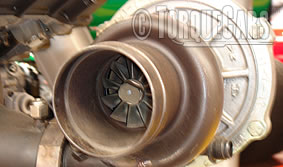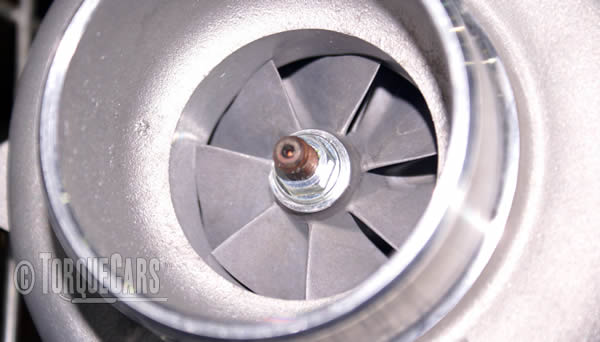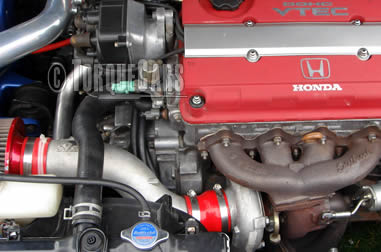Tuning turbo engines.
"A lot of hot air."

What is a turbo. If you go back to your childhood you probably remember those windmills sold at the seaside. Imagine a windmill with 2 propellers back to back.
As the wind blows the first propeller a shaft turns the second one and it will blow air in your direction.
A turbo contains 2 impellers which are located in the exhaust flow and along the intake path. The exhaust side rotates as the exhaust gases flow and this turns the impeller on the intake effectively sucking in fresh air.
So the turbo essentially generates power from the waste exhaust gases. Although sticking a propeller in the exhaust flow will reduce the exhaust efficiency the power gains on offer more than make up for this.
So who invented the the turbo? Aircraft running on fuel were altitude restricted due to the thin air and lack of oxygen this contains. By using a turbo the air could be forced into the engine and allowed the aircraft to run at higher altitudes or faster at lower altitudes.
It was not long before someone saw the application in car engines and we started to see turbos arriving in popular cars. In recent times manufacturers have been forced to produce more economical cars. With a turbo you get more power per cc making an engine more efficient. It is the power gains that TorqueCars members are most interested in, although the economy is nice to have.
The potential for turbo tuning power gains is massive. Most engines are over engineered for reliability and can take increases in power of 30-50%. Some engines can support even larger power gains. There is little surprise that in our 2 most tunable engines report, both are turbo driven.
With the advent of modern engine computer control we get a method of maximising the power produced by the turbo.
For example the exhaust gases are vented away from the turbo when certain levels of boost are reached. With a remap you can overcome this limitation. Fuel delivery also needs to matched to avoid running a lean mixture so the computer controls the timing and quantities of fuel delivery. Please review the articles on Remaps, BOVs, Boost controllers for more detailed information.
 Are there any drawbacks to turbo engines? Until the exhaust gases start to flow quickly enough there is little the turbo can do. This is manifest in what is referred to as lag where the engine seems lifeless until the turbo kicks in. The bigger the turbo the greater the lag problem. Also when you compress air you heat it up and as we all know hot air carries less oxygen than colder air. This is easily solved with an intercooler.
Are there any drawbacks to turbo engines? Until the exhaust gases start to flow quickly enough there is little the turbo can do. This is manifest in what is referred to as lag where the engine seems lifeless until the turbo kicks in. The bigger the turbo the greater the lag problem. Also when you compress air you heat it up and as we all know hot air carries less oxygen than colder air. This is easily solved with an intercooler.
No longer are we limited to a single turbo. Many cars now come equipped with Twin Turbos such as the GTO and Nissan 300zx. Big turbos are also on offer and this is the usual path an upgrader will take. We also see triple and quad turbo setups with boost controllers kicking in each turbo as exhaust flow increases for a steady power delivery.
Uprating turbos.
Adding a turbo to a standard engine is another option but there are quite a few considerations so read our turbo uprating article for a brief overview of some of the obstacles you will encounter.

Turbos are one of the best innovations in automotive engine technology.
They allow a small engine to produce similar power to much larger engines.
This enables the engine to be more efficient and with the move away from large V6 and V8 engines the turbo enables a manufacturer to build a car which has both economy and performance.
Your main aim in tuning a turbo is to enhance the airflow through the turbo. This applies equally well on the exhaust and intake side. Enlarging the intake channel and polishing the internal surfaces will dramatically reduce internal friction.
Many turbos and exhaust manifolds are cast and the casting process leaves seams and pits which dramatically affect air flow.
Using ball bearings instead of thrust bearings will allow the turbo to spool up more quickly. Ball bearings also last longer than trust bearings. Ceramic bearings have also been used for their heat resistant properties.
We should add that the larger capacity engines including the V6 and lazy V8's will produce phenomenal power gains if they were turboed as some of our serious drag racing members have discovered.
A 2.5 litre engine in NASP form will usually produce around 200-260 bhp. When the same engine is setup for a turbo we see power figures from 400 to 1000bhp.
Just a word of warning from TorqueCars - the turbo is spinning at 100,000's of RPM so be cautious when you switch off it needs oil if it is going to survive. If you switch off the engine whilst the turbo is hot you will burn off the oil inside the turbo causing excessive friction and wear.
Switching off the engine also stops the delivery of fresh oil. So allow the turbo to cool down by slowing up towards the end of your journey. Sadly people are generally ignorant of the oil and heat problem and will just switch off their engine after a spirited run.
To discuss all aspects of Turbo tuning and turbo engines with our enthusiastic and friendly car modding community please join our free forum. (You also get access to our gallery of show photos, members projects and work in progress reports!) If you have an interesting project please join up and tell us about it.
If you liked this page please share it with your friends, drop a link to it in your favourite forum or use the bookmarking options to save it to your social media profile.
Check out TorqueCars new YouTube channel, and see their awesome new content...
Feedback
Please use our forums if you wish to ask a tuning question, and please note we do not sell parts or services, we are just an online magazine.
Help us improve, leave a suggestion or tip
